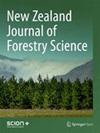无人机和智能手机在新西兰奥特亚野火管理中的集成
IF 1.1
4区 农林科学
Q2 FORESTRY
引用次数: 4
摘要
背景:从2016年起,野火应急响应首次在新西兰奥特亚大规模使用遥控飞机系统(RPAS),也称为无人驾驶或无人机和系统(UAS)或“无人机”(以下简称UAS)、智能手机和智能手机应用程序(应用程序)。这项研究概述了从2016年起,这项新技术在新西兰野火监测中的部署和使用,以及向行动人员传达火灾响应信息。方法:采用定量和定性问卷以及半结构化访谈的方法,收集野火管理人员对这项新兴技术使用情况的反馈。使用回顾性分析对结果进行分析,以确定感知随时间的变化。讨论了所提出的问题,以及消防管理人员和人员在新西兰野火中采用此类技术的情况。调查结果:自2016年以来,无人机与视觉、红外/红外热传感器的集成已在新西兰各地的十多起野火管理响应事件中使用。从最初的观点来看,对信息技术在野火管理应对中的使用和效益的定量认知有所改善,分别从漠不关心到强烈支持,以及从支持到强烈支持无人机和智能手机的使用。定性分析表明,在将新技术与野火管理业务整合后,对新技术的积极看法都有所增加,而冷漠和消极的看法则大幅减少。结论:无人机等技术的使用已经获得了支持,目前有可能提高安全性,降低抑制和清除成本。减少热点检测和管理所需的时间,再加上将重型飞机从此类任务中重新部署的能力,将提高成本和资源利用率。无人机作为遥感设备(如相机和激光扫描仪)和智能手机应用程序的平台,现在被运营和事件管理人员视为在新西兰野火中部署的重要工具。采用任何新的系统或技术都需要灵活性,特别是在管理支助方面,定期提供信息、培训和指导应被视为至关重要。本文章由计算机程序翻译,如有差异,请以英文原文为准。
UAS and smartphone integration at wildfire management in Aotearoa New Zealand
Background: From 2016, wildfire emergency response used Remotely Piloted Aircraft Systems (RPAS) also known as Uninhabited or Unmanned Aerial Vehicles (UAVs) and Systems (UAS) or "drones" (hereafter UAS), smartphones and smartphone applications (apps) on-site, for the first time at scale in Aotearoa New Zealand (hereafter New Zealand). This study outlines the deployment and use of this new technology in monitoring at wildfires in New Zealand from 2016, and the conveyance of fire response information to operational personnel.
Methods: A quantitative and qualitative questionnaire, and semi-structured interviews were used to gather feedback on the use of this emerging technology from wildfire management personnel. The results were analysed to determine perception change over time, using retrospective analysis. The issues presented, and the uptake by fire management and personnel for the incorporation of such technology at wildfires in New Zealand are discussed.
Findings: The integration of UAS and visual, infrared/infrared-thermal (IR/TIR) sensors has been used at over ten wildfire management response incidents throughout New Zealand since 2016. The quantitative perception of use and benefit of information technology in wildfire management response improved from the initial viewpoints, from indifferent to strongly supportive, and supportive to strongly supportive for UAS and smartphone use, respectively. Qualitative analysis showed that both positive views on the new technology increased, and indifferent and negative views diminished substantially following exposure to its operational integration into wildfire management.
Conclusions: The use of technology such as UAS has gained support and currently offers the potential to increase safety and reduce suppression and mop-up costs. A reduction in the time taken for hotspot detection and management, combined with the ability to redeploy heavy-lift aircraft away from such tasks would lead to efficiencies in cost and resource utilisation. UAS as platforms for remote-sensing devices (such as cameras and laser scanners), and smartphone apps are now considered important tools for deployment at New Zealand wildfires by operational and Incident Management personnel. The adoption of any new systems or technology requires flexibility, especially in terms of management support, in which regular information, training and instruction should be considered crucial.
求助全文
通过发布文献求助,成功后即可免费获取论文全文。
去求助
来源期刊

New Zealand Journal of Forestry Science
FORESTRY-
CiteScore
2.20
自引率
13.30%
发文量
20
审稿时长
39 weeks
期刊介绍:
The New Zealand Journal of Forestry Science is an international journal covering the breadth of forestry science. Planted forests are a particular focus but manuscripts on a wide range of forestry topics will also be considered. The journal''s scope covers forestry species, which are those capable of reaching at least five metres in height at maturity in the place they are located, but not grown or managed primarily for fruit or nut production.
 求助内容:
求助内容: 应助结果提醒方式:
应助结果提醒方式:


